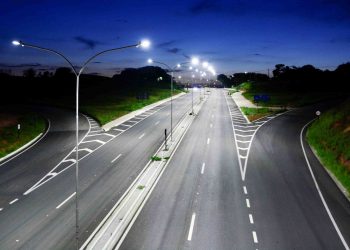
Street Lighting: learn everything about the most important norms and certifications
(this post deatils information about the current regulations for Brazil)
Several changes have occurred in recent decades for street lighting manufacturers due to advances in technology. Today, street lighting has increasingly advanced devices with the use of LED or light-emitting diodes. This reduces energy consumption costs and makes the acquisition of the lighting project a good investment for the business.
In this post, we will show you how street lighting works and what a company needs to manufacture and market public luminaires, as well as the necessary certifications and the main norms to be followed. Enjoy reading!
How does street lighting work?
Article 30 of the 1988 Brazilian Federal Constitution determines that it is the responsibility of the Municipal Public Power to provide local public services of interest, under a concession or permission regime. This includes street lighting, whose oversight responsibility has been passed on to the National Electric Energy Agency (ANEEL).
Electricity distribution and transmission to small and medium consumers is carried out by electric power companies, starting from generating units. Brazil has approximately 60 concessionaires that manage and operate transmission lines. ANEEL regulates the sector and oversees concessionaires to ensure compliance with laws and technical specifications.
Resolution Normative nº 414/2010 published by ANEEL regulates the conditions of energy supply. The said resolution was amended in 2012 by Normative Resolution nº 479, which established in its Article 218 the obligation of the distributor to transfer the Fixed Assets of the street lighting system to the municipalities, being responsible for the execution and cost of operations and maintenance.
What does a company need to manufacture and market public luminaires?
Manufacturers of public luminaires and their products need to comply with all existing laws in our country, especially the Technical Quality Regulation for Luminaires for Street Lighting of Roadways of the National Institute of Metrology, Quality and Technology (Inmetro), which is listed as Annex I of Ordinance nº 20/2017. See below the requirements to be followed by manufacturers!
Necessary certifications
They are related to the safety, performance, and reliability of public lighting and were launched by Inmetro, which develops quality certification and conformity assessment programs. Compliance is assessed with equipment that verifies whether products have been manufactured in accordance with standards and minimum requirements.
Inmetro performs quality tests and certifies that devices and equipment are effective and reliable. It is Ordinance nº 20/2017 that deals with LED luminaires for public roads, and certification is effected by Product Certification Bodies with Inmetro’s support. They attest if the products comply with the standards of the Brazilian Association of Technical Standards.
The Inmetro conformity seal is mandatory, and certified luminaires have the National Energy Conservation Label (ENCE) on their box. It must contain the issuance number, manufacturer information, and product data. Certification guarantees that the consumer is buying a reliable device, as factories are annually audited.
Standards to be followed
All Brazilian standards must be followed by manufacturers of street luminaires. The street lighting system follows projects and material definitions that ensure energy efficiency, in addition to meeting the requirements of NBR 5101:2018. It establishes the mandatory aspects of road lighting to provide safety on the roads.
Ordinance nº 20/2017 contains the technical specifications of products, making it clear in its Article 3 that luminaires marketed in Brazil cannot compromise consumer safety. The norm’s text brings the concepts related to LED technology or light-emitting diodes, as well as the legal requirements for device production.
Inmetro Regulation
The regulation of public street lighting came into effect on August 20, 2018, through Inmetro’s Ordinance No. 20. The document containing the mandatory certification rules is accessible to all manufacturers and traders of equipment, which are subject to testing in laboratories to receive the ENCE label.
The manufacture and importation of luminaires without the Inmetro seal is prohibited. Before making a purchase, research to verify if the factory is certified. You can check on Inmetro’s website, through public consultation of information on national importers or manufacturers.
Equipment standards
There is a diversity of equipment available in the market for public lighting projects. However, they must comply with the standards required by the aforementioned Ordinance No. 20, to receive certification and be made available to consumers. The installation must also comply with the standards of the already mentioned NBR 5101:2018.
This standard contains all the conditions for the proper and efficient installation of LED luminaires. The concessionaires, in turn, establish a mounting standard for each situation. Internal regulations present the details and positioning of the components, so as not to contravene other laws.
Lighting project specifications
LED lighting projects are developed by specialized professionals who perform energy efficiency calculations. They determine the right equipment, how they should be arranged, the measures for installation, the angle, and all factors related to ambient brightness.
Technical characteristics
The best LED street luminaires have Inmetro certification and technological optimization, in addition to offering excellent performance with surge protectors. They are adjustable, impact-resistant, may or may not be dimmable, and maintenance is facilitated by having a tool-free system and Philips technology drives. They are available in the SX-INLPI Fortika Luminaire model from 30 to 250W, the SX-INLPP Plus Luminaire model from 20 to 150W, and the SX-EVO Evolution Luminaire model from 20 to 60W.
Why is it important to follow rules for street lighting?
Following rules for public lighting is extremely important to avoid breaking legal determinations and suffering the consequences of infringing laws. Standards are created to provide safety and prevent accidents that cause damage to public resources and human lives. They also aim to conserve and preserve the environment.
LED luminaires do not emit carbon dioxide, avoiding pollution and generating savings in public resources, functioning at the same time as an investment and sustainable action. They also offer visual comfort, reducing glare during nighttime periods and improving visual performance. Therefore, many municipalities have already created laws that require the implementation of this technology.
Now you know what rules and certifications must be observed by manufacturers of public luminaires. SX Lighting provides cutting-edge technology products with excellence in quality. In addition to showing which are the ideal devices to meet your needs, they also offer an ideal lighting project for your infrastructure.
Do you want to obtain more information about LED lighting products for industries, supermarkets, and street lighting? Contact our experts right now and request your quote!
Share







